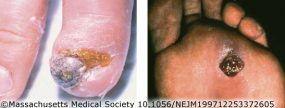
Trench Fever,

Bartonella bacteria cause several diseases in humans. The most common is cat scratch disease.
Symptoms

Enlarged lymph node resulting from cat scratch disease. Used with permission of NEJM.
Cat scratch disease (CSD), Bartonella henselae
- Low-grade fever
- Enlarged, tender lymph nodes that develop 1–3 weeks after exposure
- A papule or pustule at the site of the scratch
Rarely, eye infections, severe muscle pain, or encephalitis (swelling of the brain) may occur.
Trench fever, Bartonella quintana
- Fever (may occur once or repeatedly)
- Headache
- Rash
- Bone pain, mainly in the shins, neck, and back
Carrión’s disease, Bartonella bacilliformis

Verruga peruana, mular form. Used with permission of NEJM.
This disease has two distinct phases:
- Oroya fever: During this phase, fever, headache, muscle aches, abdominal pain, and severe anemia may occur.
- Verruga peruana (Peruvian warts): During this later phase, growths form under the skin and develop into red-to-purple vascular sores that can become raw or bleed.
Other complications
Bacillary angiomatosis
Bacillary angiomatosis (caused by B. henselae or B. quintana) and bacillary peliosis (caused by B. henselae) occur primarily in people with weakened immune systems, such as those with advanced HIV infection. Bacillary angiomatosis may result in lesions in the skin, under the skin, in bone, or in other organs. Bacillary peliosis causes sores in the liver and spleen.

Bacillary angiomatosis. Used with permission of NEJM.
Subacute endocarditis
Many Bartonella species can cause infection of the heart valves (subacute endocarditis), which is often culture negative.
Transmission

Vectors of Bartonella infections include fleas, body lice, and sand flies.
Cat scratch disease (CSD), Bartonella henselae
People can get CSD from the scratches of domestic or feral cats, particularly kittens. The disease occurs most frequently in children under 15. Cats can be infested with infected fleas that carry Bartonella bacteria. These bacteria can be transmitted from a cat to a person during a scratch. Some evidence suggests that CSD may be spread directly to people by the bite of infected cat fleas, although this has not been proven.
CSD occurs worldwide, wherever cats live. Stray cats may be more likely than pets to carry Bartonella. In the United States, most cases of CSD occur in the fall and winter.
Ticks may carry some species of Bartonella bacteria, but there is currently no causal evidence that ticks can transmit Bartonella infection to people through their bites.